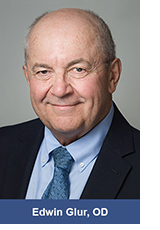
Dr. Sean P. Templeman has joined
Dr. Templeman is a native of southern Minnesota and attended Marquette University in Milwaukee, WI, receiving his Bachelor of Science in Biomedical Sciences. He then moved to Boston, MA for his optometric training at the New England College of Optometry. After receiving his Doctorate of Optometry, he completed his residency in Primary Care and Ocular Disease at Edith Nourse Rogers Memorial Veterans Hospital just outside Boston. Dr. Templeman will work primarily at our downtown office in the Medical Arts Building (612-338-4861) and will see patients at our Park Avenue office as well.
After more than 18 years at Eye Care Associates, Dr. Edwin Glur retired effective July 31, 2018. “I have seen some of my patients for the entire 18 years that I have been working at the practice,” said Dr. Glur. “The hardest part of leaving is seeing those personal relationships with patients come to an end.” Dr. Glur has 11 grandchildren, and his top priority in retirement is to spend more time with them. He and his wife Deanna are looking forward to traveling to warmer destinations in the winter. Dr. Sean P. Templeman has been hired to replace Dr. Glur. For more information on Dr. Templeman please see the article above.
There are many ways to treat presbyopia
The definition of presbyopia is when your eyes gradually lose the ability to see things clearly up close. This condition is a normal part of aging, and in fact the Greek word “presbyopia” means “old eye”. Many people notice the symptoms of presbyopia shortly after turning 40; one of the most common symptoms is that people need to hold reading materials farther away in order to see them clearly. There is no way to stop or reverse the normal aging process that causes presbyopia. Presbyopia treatments: 1. Reading glasses When presbyopia is the only vision problem (no nearsightedness, farsightedness or astigmatism), glasses may be the only solution that is necessary. Reading glasses help correct close-up vision problems because they bend light before it enters the eye. 2. Bifocals, trifocals or progressive lenses People who already wear eyeglasses for other vision problems may need to move to bifocals, trifocals or progressive lenses.
Study suggests education causes myopia
For more than a century various studies have linked education with myopia. However, until now researchers have not been able to shed light on whether one causes the other or if a third factor is responsible. Various prospective trials have shown that the risk of myopia is reduced by the amount of time spent outdoors. The study has been difficult to conduct. One reason is because researchers have not been able to rule out the hypotheses that being myopic actually stimulates people to spend more time studying. They also have not been able to determine whether a factor such as intelligence or higher socioeconomic status could do two things; cause myopia and lead people to spend more time studying. |

 Fall is a season when Minnesotans remain very active due to the more temperate weather. Bike riding, golfing and hiking are popular activities in the autumn months. All these activities are enhanced for people who don’t have to worry about glasses or contacts.
Fall is a season when Minnesotans remain very active due to the more temperate weather. Bike riding, golfing and hiking are popular activities in the autumn months. All these activities are enhanced for people who don’t have to worry about glasses or contacts.
 Dr. Edwin Glur’s retirement
Dr. Edwin Glur’s retirement What is Presbyopia?
What is Presbyopia? According to researchers at the University of Bristol, UK, the more educated a person is, the more myopic they are likely to become.
According to researchers at the University of Bristol, UK, the more educated a person is, the more myopic they are likely to become.